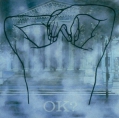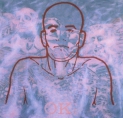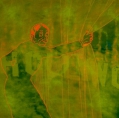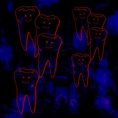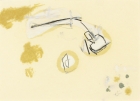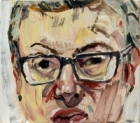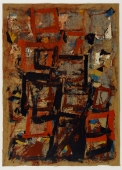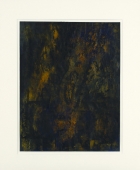
Artist | Michael Cook (*1953)
https://www.artist-info.com/artist/Michael-Cook
Biography
Biography
Born: Aguadilla, Puerto Rico, 1953
Residence: Albuquerque, New Mexico
Master of Fine Art, University of Oklahoma, 1978
Master of Art, University of Dallas, 1976
Bachelor of Fine Art, Florida State University, 1975
Central High School, Bushey, Hertfordshire, England, 1971
Solo Exhibitions (selection)
Solo Exhibitions (selection)
Michael Cook, Instructions: Paintings 1991-1996,The Center for Contemporary Arts, Santa Fe, New Mexico November 22, 1996 - January 4, 1997
Animal, Vegetable, Mineral?, Gallery A, Chicago, Illinois, July 30 - August 28, 1993
Michael Cook, The Suite: Animal, Vegetable or Mineral?, Alcove Exhibition, Museum of Fine Arts of the Museum of New Mexico, Santa Fe, New Mexico, March 3 - July 10, 1990
Michael Cook: Charity, large scale drawings, Shidoni Contemporary Gallery, Tesuque, New Mexico, March 2 - April 2, 1990
Michael Cook: Recent and Past Work, University Art Museum, University of New Mexico, Albuquerque, New Mexico, January 17 - March 19, 1989
Michael Cook: Suite 71645, Painting and Drawing, Janet Steinberg Gallery, San Francisco, California, April 30 - May 31, 1986
Michael Cook: Paintings and Drawings, The Wenger Gallery, San Diego, California, February 24 - April 2, 1984
Michael Cook: Paintings and Drawings, The Grayson Gallery, Chicago, Illinois; March 25-April 26, 1983
Michael Cook: Drawings, Barat College, Riecher Gallery, Lake Forest, Illinois (Chicago), November 17 - December 17, 1982
Michael Cook, Paintings, Drawings, N.A.M.E. Gallery, Chicago, Illinois, March 1982
Selected Video Works, Contemporary Arts Center, Cincinnati, Ohio, September 24, 1981
Screen Test - Work In Progress, Tangeman Fine Arts Gallery, Cincinnati, Ohio, October 1979
Remains, Clifford Gallery, Dallas, Texas, November 4 - December 2, 1978
Container, Contained, Remains, Lightwell Gallery, University of Oklahoma, March 1978
Group Exhibitions (selection)
Group Exhibitions (selection)
Re-Inventing the Emblem: Conternporary Artists Recreate a Renaissance Idea, Yale University Art Gallery, New Haven, Connecticut, January 20 - March 26, 1995
Worlds at Risk: Dangerous Environments and Vanishing Traditions, Cambridge Multi-Cultural Arts Center, Cambridge, Massachusetts, September 30 - Decernber 30, 1993
Art of This Century, 30th Anniversary Exhibition 1963-1993, University Art Museum, University of New Mexico, Albuquerque, New Mexico, September 26 - December 19, 1993
The End of the Millennium, Nautilus Foundation, Inc., Tallahassee, Florida, curated by Robert Fichter, March 1993
21 Steps, University Art Museum, University of Arizona, Tueson, Arizona, March 22 April 28, 1993
21 Steps, Jonson Gallery, The University of New Mexico, Albuquerque, New Mexico, August 25 - October 2, 1992
Playing With Fire, Center for Contemporary Art, Santa Fe, New Mexico, November 9 - December 15, 1990
18 Artists: 18 Major Works, 1800 Clybourn, Chicago, Illinois, August 18 - October 15, 1990
20 x 24, Jayne Baum Gallery, New York, New York, June 25 - July 20, 1989
Drawings, lannetti/Lanzone Gallery, San Francisco, California, May 25 - July 1, 1989
Still Life, Daley College Gallery, Chicago, Illinois, August 15 - September 20, 1989
Centennial Polaroid Exhibition, University Art Museum, University of New Mexico, Albuquerque, New Mexico, January 17 - March 19, 1989
Visions, Contemporary Photography in New Mexico, State of New Mexico Fine Arts Gallery, Albuquerque, New Mexico, February 11 - 26, 1989
Get It On Paper! An exhibition of works on paper, Linda Durham Gallery, Santa Fe, New Mexico, November 1988
Social Space, Janet Steinberg Gallery, San Francisco, California, February 1988
New Work From the Bay Area, Center for the Visual Arts, Boulder, Colorado, January 8 -February 11, 1988
Small Works Invitational, Janet Steinberg Gallery, San Francisco, California, December 3 -December 19, 1987
Myth & Magic, The Wenger Gallery, Los Angeles, California, July 1987
The End of the World: Contemporary Visions of the Apocalypse, The New Museum of
Contemporary Art, New York, New York, December 10, 1983 - January 22, 1984
Disarming Images: Film & Video, Contemporary Arts Center, Cincinnati, Ohio, October 13, 1984
Drawings by Sculptors, Museum of Fine Arts, The Museum School Gallery, Boston, Massachusetts, October 13 - November 6, 1983
System & Structure: Seven Chicago Artists, University of Wisconsin, Green Bay, September 10 - October 13, 1983
University of Wisconsin, Oshkosh, Allan Priebe Art Gallery, October 18 - November 10, 1983
Burpee Art Museum, Rockford, Illinois, November 12 - December 11, 1983
Ukrainian Institute of Modern Art, Chicago, Illinois, January 12 - February 24, 1984
Disarm Show / War Games, The Kitchen, New York, New York, June 1982
Invitational Drawing Exhibition, C.A.G.E., Cincinnati, Ohio, September 1981
Working Drawings, Hunter Gallery, New York, New York, March - April, 1981
Working Drawings, Randolph Street Gallery, Chicago, Illinois, June 1981
New Dimension - Time, Museum of Contemporary Art, Chicago, Illinois, February 22, April 27, 1980
Radiation Remains the Same, Image Union, WTTW (Channel 11), Chicago, Illinois, July 10, 1981
Selected Video Works, in conjunction with Magnetic Image Program, Cable Atlanta (Channel 10), 9:00 PM, February 23, 1981
Magnetic Image 6 International Invitational Video Exhibition, Atlanta College of Art Gallery, Atlanta, Georgia, August 15 - September 15, 1980
Works on Paper, Tony Birckhead Gallery, Cincinnati, Ohio, November, 1979
The 77th Annual Exhibition by Artists of Chicago und Vicinity: Works on Paper, Art Institute of Chicago, Chicago, Illinois, November - December, 1978
Grants / Fellowships, Awards
Grants / Fellowships, Awards
University Research Grant, University of New Mexico, 1990-91
Research Allocations Committee Grant, University of New Mexico, 1988-89
National Endowment for the Arts, Individual Artists Fellowship, 1985-86
Illinois Arts Council Individual Visual Artist Fellowship, 1982
Ford Foundation Faculty Research Grant, 1979
Ford Foundation Faculty Research Grant, 1978
Outstanding Teacher of the Year Award for excellence in undergraduate teaching 1989-90, The University of New Mexico, Albuquerque, New Mexico
Teaching
Teaching
Presently: Associate Professor of Art, Painting and Drawing, Department of Art and Art History, University of New Mexico, Albuquerque, New Mexico
Bibliography
Bibliography
"Michael Cook, INSTRUCTIONS: Paintings 1991-1996", catalog, David Leeming, Center for Contemporary Arts of Santa Fe, November 22, 1996 to January 4, 1997
"Reinventing the Emblem: Contemporary Artists Recreate a Renaissance Idea", Allison Leader, Richard Field, catalog, Yale University Art Gallery, January 20March 27, 1995
"21 Steps", catalog, Joseph Traugott, Jonson Gallery, University Art Museum, University of New Mexico, 1992
"The End of the Century, The End of the Centuries 990 to the Present", Hillel Swartz, Doubleday, 1990, p. 250
"The Alcove Show, New in New Mexico", Museum of Fine Arts, Santa Fe, brochure, Sandi Ballatore
"Photography at The University of New Mexico", PhotoEducation, Volume 6, No. 4, Spring 1990
"Playing With Fire", catalog, Center for Contemporary Arts of Santa Fe, 1990, Diane Armitage, includes artist statement
"Visions Shows Caliber of State's Photographers", Albuquerque Journal, February 17, 1989, William Clark
"Images of Science, Art Meet on Canvas", Albuquerque Journal, January 20, 1989, Bonny Christina Celine
"Signs of The Global Village", Art Week, February 6, 1988, Volume 19, #5, p. 5, Ina Russell
"California Artists Command Attention in Denver", Rocky Mountain News, January 15, 1988, p. 14, Jennifer Heath
"San Franciscans Art Promises More ...“, Denver Post, January 8, 1988, p.20, Irene Rawlings
"Filtering Apocalypse Through Illusions", Kenneth Baker, San Francisco Chronicle, May 13, 1986
"Angles of Emotionalism", Charles Shere, Oakland Tribune, May 6, 1987
"The Other Traditon Grows Up", Michael Segrad, New Art Examiner, March 1984, p.8
"When Artists Portray Utopia and Armageddon", New York Times, Gallery View by Grace Glueck, Sunday, January 15, 1984
"The Day Before", The Village Voice, Kim Levin, January 3, 1984, p. 4
"Visualizing the End of the World: Contemporary Visions of the Apocalypse," catalog, Lynn Gumpert, The New Museum of Contemporary Art, New York, New York, 1983
"System & Structure: Seven Chicago Artists," catalog, University of Wisconsin, Larry and Sandra Conn, Chicago, Illinois, 1983
"Seven Artists Address System and Structure", Chicago Sun-Times, Harold Haydon, February 17, 1984, p. 74
„Radiation Remains the Same", multiple audio work, Grayson Gallery, March, 1983
New Art Examiner, May/June 1983, Joshua Kind, review of Grayson exhibition
"Video Artists Respond to Disarmament Call", Kathleen Hulser, video/film, The Village Voice, June, 1982
"Chicago is Enjoying Its Own Eclecticism", May 1982, Art News, David Elliott, p. 94
New Art Examiner, May 1982, vol. 9, no. 8, Pat Thomson, review of N.A.M.E. Exhibition, p. 15
"These Artists Paint Modern Visions", March 14, 1982, Chicago Sun-Times, David Elliott, p. 38
IAC Quarterly, Spring 1982,'Artists: IAC Award Fellowships', p. 2
"New Dimensions - Time", brochure, Pauline A. Saliga, Museum of Contemporary Art, Chicago, Illinois, 1980
Chicago Sun-Times, April 6, 1980, David Elliott, review of "New Dimensions - Time"
New Art Examiner, April 1980, D. Bright, review of "New Dimensions - Time", p. 23
New Art Examiner, June 1980, reply to review of April 1980, p. 26
"Magnetic Image Six", International Invitational Video Exhibition, catalog, Ben Davis, Atlanta College of Art, 1981
"Mail ETC., Art", catalog, Fichter, Donohaue, Koslow, Becotte, University of Colorado, Boulder, Tyler School of Art, p. 20, 1980
Art News, March 1979, vol. 78, no. 3, Janet Kutner, "Gra-Feet-I, Glitter and Crab Claws", p. 132
"Cook's 'Footsteps' Works Fascinate", December 5, 1978, Dallas Morning News, Janet Kutner, p. 14-A
"Beo", December - January 1978 - 1979, Senoj, Inc., Atlanta, Georgia. Work published in book form regarding the display of entertainment, judgement, research and dialogue
"Works on Paper - 77th Exhibition of Artists of Chicago and Vicinity", catalog, Esther Parks, Art Institute of Chicago, 1978
"Magnetic Image 4" National Invitational Video Exhibition, catalog, Ben Davis, Atlanta College of Art
"Appalachian National Drawing Exhibition", eatalog, Vito Acconci, Farthing Art Gallery, Appalachia State University, Boone, North Carolina, March, 1978
Contemporary Arts Southeast, 1977, vol. 1, no. 3, Sarah Daniels, article on production of Beo
"Twentieth Annual Delta Art Exhibition", catalog, Marcia Tucker, Arkansas Art Center, Little Rock, 1977
Public and Private Collections (selection)
Public and Private Collections (selection)
The New Museum of Contemporary Art, New York, New York
The Museum of Contemporary Art, San Diego, California (Formally The La Jolla Museum of Contemporary Art)
Polaroid International Collection, Polaroid Corporation, New York, New York
Mr. & Mrs. Kurt Shuler, Rancho Santa Fe, California
Mr. & Mrs. Sol Price, La Jolla, California
World Book Corporation, Chicago, Illinois
University Art Museum, University of New Mexico, Albuquerque, New Mexico
Edith & Murray Altman, Chicago, Illinois
Sandra Conn and Associates, Chicago, Illinois
Laurence Conn, Chicago, Illinois
Janet Steinberg, Tiburon, California
Henry Luce 3rd, New York, New York
Museum of Modern Art, New York, New York (Work contained in the volume Beo, artists book collection, produced by Ben Davis and George Hemphill)
Mr. John Penhune, La Jolla, California
Mr. & Mrs. Charles Taubman, Rancho Santa Fe, California
James & Juliana Bancroft, Los Angeles, California
Ivy Hofstadter, Glencoe, Illinois
Mr. & Mrs. Thomas Barrow, Albuquerque, New Mexico
Patrick Nagatani, Albuquerque, New Mexico1968 Galerie Ricke, Kassel
1969 Galerie Ricke, Köln
Von-der-Heydt-Museum, Wuppertal
1970 Galerie Kuhn, Aachen
Galerie Renée Ziegler, Zürich
1971 Galerie Toni Gerber, Bern
Galerie Möllenhoff, Köln
1972 Galerie Möllenhoff, Köln
Galerie Volante Toni Gerber, Kabul
1973 Kölnischer Kunstverein, Köln
Kunstmuseum, Luzern
Galerie Pablo Stähfi, Luzern
Galerie Oppenheim, Köln
1974 Galerie Loeb, Bern
Galerie Vandres, Madrid
Galerie Oppenheirn, Köln
1975 Galerie Magers, Bonn
Oppenheirn-Studio, Köln
1976 Forum Kunst, Rottweil
1977 Städtisches Museum Schloß Morsbroich, Leverkusen
Kunstmuseum, Düsseldorf
1978 Städtische Galerie, Ravensburg
1979 Galerie Toni Gerber, Bern
Galerie Bama, Paris
Galerie 't Venster, Rotterdam
1980 Museum Folkwang, Essen
Kunstverein, Kassel
1981 Galerie Munro, Hamburg
Bernier Gallery, Athen
Galerie Bama, Paris
Galerie nächst St. Stephan, Wine
1982 Galerie Krinzinger, Innsbruck
Art in Progress, München
Galerie Baronian/Lambert, Gent
Gallery Holly Solomon, New York
1984 Museum van Hedendaagse Kunst, Gent
Museum Villa Stuck, München
1985 Galerie Dietmar Werle, Köln
1986 Düsseldorf, Galerie Schmela, Düsseldorf
Galerie Bama, Paris
1986/87 Museum Ludwig, Graphisches Kabinett, Köln
1988 Louisiana Museum of Modern Art, Humlebaek
Galerie Pablo Stähli, Zürich
1989 Württembergischer Kunstverein, Stuttgart
1989/90 Galerie Crousel-Robelin, Paris
1990/91 Nationalgalerie, Belrin
1991 Galerie Curtze, Wien
A.C.R. Galerie, Eltville
1992 Galerie Curtze, Düsseldorf
Galerie Gutsch, Belrin
1993 Galerie Holtmann, Köln
Berlin, Galerie Gutsch
1994 Galerie Orangerie-Reinz, Köln
Galerie Krips, Köln
Kunstverein Arnsberg
Galerie Ribbentrop, Eltville
21 Steps, Portland, Oregon
Acknowledgements
Acknowledgements
In 1990 The Center for Contemporary Arts first exhibited several of my large paintings in a group exhibition entitled "Playing With Fire" curated by Robert Gaylor and Diane Armitage. lt was at that time that I first began to develop this body of work. The years since have been fruitful. I am forever grateful to The Center for Contemporary Arts (then as now) for the opportunity to share this body of work with New Mexico.
A significant portion of my life has been devoted to education. Nick Abdalla, Martin Facey, Patrick Nagatani, and John Wenger are colleagues at the University of New Mexico who over the years have been unfailing in their humor and moral support thorough trying times, and whose belief in the power of art has been inspirational.
David Leeming wrote a wonderful essay, both insightful and informative. For this I am very grateful.
In the end nothing is possible without my family. Vera Sprunt and sons Nigel and Avery, with their unfailing love, sustain me through all.
About the work (english)
About the work (english)
MANIFEST DESTINY - The Art of Michael Cook
For some time now Michael Cook has been living and painting in New Mexico, and his paintings since the late eighties reflect both his understanding of the beauty of his surroundings and his recognition of the threat to its sacred ecology or wholeness. In turn, what Cook sees in New Mexico and the West and, in fact, the nation, is a reflection of what he sees in the contemporary world as a whole. In darkly ironical paintings of the late eighties he attempted to come to terms with the glory and horror of his environment, both local and general. In so doing he revealed a world of nuclear waste repositories under the desert wilderness and exposed the "Land of Enchantment" (and, by extension, the "Land of the Brave") as a secret "lab" for a desolate future.
In this present exhibition, Cook turns his attention to what he calls "mythic American monuments both literal and implied." Embedded in his new works are questions relating to a national mythos contained in such political and cultural phrases as "Manifest Destiny", "liberty and justice for all", "the Golden West", and "the American Way" and to the monuments that represent them. The body of work as a whole is entitled Instructions. The artist's concern is how these icons or monuments exist in the American psyche as „acts of memory" and how these acts of memory can "instruct" us as Americans. When we look at the paintings we begin with monuments such as the Statue of Liberty, Mount Rushmore, or the Supreme Court Building clothed in a smoky mist of dream and myth, and our first impression is of the traditional "instruction": the Statue of Liberty, for instance, stands in our national memory for Liberty and the Supreme Court for Justice. But, through distinctive coloring, symbolic details, and a novel technique of layering, the artist presents us with new, less traditional instructions. In several of the new paintings a line drawing face of a Daddy Warbucks/Mr. Clean figure seems gradually to emerge and to superimpose itself on the monument in question. The figure takes many forms but is perhaps always us--the audience as well as the painter--the participators in the process by which we allow ourselves to be contained by the destructive lies of our culture. Several paintings in the series contain the letters "OK“, which add to the irony already present in the juxtaposition between the ubiquitous face and the monuments. "OK“ was, we remember, originally a military term meaning "Orders Known," used before executing a command.
When we look at the painting of Mount Rushmore, for instance, (painted ironically in the commercially labeled hue of "Indian Red") and gradually become aware of the sinister Mr. Clean taking command of it, are we echoing the "OK" we see there? Are we celebrating the myth of the four presidents (clearly decomposing when we look at the details of their faces), or are we finally recognizing the carving on the mountain as a desecration of the sacred Black Hills, as graffiti on land stolen from the Indian people in the name of Manifest Destiny?
Related questions arise from the painting of the Statue of Liberty and our gradual realization of the presence in it of a secondary line painting of "Miss Liberty" in restraints, or from the painting of the Supreme Court Building with its obscenely-distorted frieze and its larger than life line figure plagued by a pain in the neck.
A less obvious instruction is contained in the particularly elegant painting of an old reconstructed southern mansion revealed behind a mist of green with little spots some viewers might see romantically as fireflies and some as bruises on a southern mythology which veils undermining social and historical realities.
In one of the most complex of the new paintings we view Disneyland's Magic Kingdom through a purple/violet-the color of royalty--layer of misty memory. As an icon of American nostalgia it is undermined and its essential tackiness revealed by a series of cadmium yellow/orange teeth that float out from and over the castle like dancing sugar-plum fairies, bearing ironical "happy faces" reminding us of decay and the dentist's eternal words: "It's not going to hurt" (read: denial). Of course, we know it always does hurt. A still closer look at the painting shows us decay expressed in paint that seems, like the faces on Cook's Mount Rushmore, to be decomposing.
Cook's art, then, is at once abstract, realistic, and mysterious--even mystical. Like the bubble chamber images used in his earlier work of the seventies and eighties, these new paintings present a vision of a seemingly abstract world, which we gradually perceive to be reality itself, a reality which changes our understanding of our nature and our being. The paintings suggest the generally unseen essence of our experience--our physical, psychological, and political experience. They force us as Americans, for instance, to meditate on the real and sometimes terrifying trails left by the interaction between our myths and our deeds--in our wars, in our environment, in our history, in our everyday lives.
Michael Cook never thinks of his paintings as a substitute for reality, though; we can always appreciate his art for its energy and power as painting. We are drawn into the ideas by the painting, not into the painting by the ideas. The flatter and drier tone of the surface and texture of the new works reflect, for instance, not only the desert environment of New Mexico and the dwindling of its resources, but the drying up of a whole culture's values. As Cook's political point of view has developed, so have the formal and textural qualities of his paintings. Throughout his career, he has made use of the materials of his art and the places in which his paintings were shown in such a way as to express his sense of the artwork as "cultural residue" or „artifact of experience."
In his paintings of the late 1970s, for example, Cook turned to the bubble chamber image and device as not only his central metaphor but as itself the actual subject of a series of paintings. To the majority of his viewers these paintings of lines and curves and dots and spirals were as abstract as the intricate compositions of Mondrian or the conceptual wall drawings of Sol LeWitt.
The viewers were right only in the sense that the abstract painter attempts to achieve a representation of the form and energy behind the surface of experience. To Cook--and certainly to the nuclear physicist who might have seen the paintings--however, these paintings were purely realistic „quotes" or appropriations from bubble chamber photographs, and, therefore, purely "representational" works. But, of course, the paintings were themselves metaphors. Like the bubble chambers, they were Containers of energy, windows to the mystery of existence. The galleries in which they hung were also Containers of energy, aesthetic variants on the metaphor of bubble chambers in which the painter's energy had to collide with the energy of his audience during a "contained" segment of time. In one of his early shows Cook found expression for this interaction between the painter and his audience, by allowing graphite that had fallen from wall drawings to be tracked across the gallery floor, creating the basis for reconfigurations that Janet Kutner in Art News called "primordial and elegant" works of art and that Cook called "Remains"--remains like the elegant photographs of bubble chamber spiral trails that illuminate the relationship between proton and electron.
A significant theme in Cook's painting has been alchemy, not so much in the sense of literally making lead into gold as in the psychological and metaphysical sense of the process by which wholeness can develop out of brokenness. Into the bubble chamber images of his paintings in the early eighties, the ainter interjected alchemical symbols, making the bubble designs less literal and more metaphorical. So the spiral becomes a mandala and the old lines, through the technique of bringing them up through levels of paint, seem to glow mystically on the muted surfaces of the works.
In a 1983 exhibit at the Grayson Gallery in Chicago Cook extended the use of his alchemical images by making them more literally figurative even as they took on a more abstract symbolic burden. In one painting the alchemical sign for "work completed" is a bright red form on a black background set off by a mysterious white city emitting light on the horizon. What Cook is doing here is conflating alchemy and his own developing social vision.
This conflation becomes increasingly clear in the mid eighties when the Cold War was at its height. The paintings of this period become increasingly political and ironical. In one painting entitled "Ashes," for example, a mandalic "Happy Face", Cook's Earth symbol, is overshadowed by a looming bomb.
The apocalyptic theme in Cook's paintings comes fully into its own in a 1986 San Francisco show at the Janet Steinberg Gallery called "Suite 71645". July 16th is Cook's birthday and the date of the moon walk launching. July 16, 1945 was also the date on which, in the New Mexican desert a plutonium atom bomb was tested; both the artist's life and American achievements are overshadowed by the reality of the nuclear shadow. The mystical alchemical spirals of Potential wholeness in the bubble chamber photographs and Cook's early paintings give way here, as they did in our cold war mentality, to the smoky mushroom cloud of the nuclear holocaust.
Using a Soviet pamphlet of "nuclear survival" for his core images and Sir James Frazer's "The Periodic Expulsion of Evil in a Material Vehicle" as a theme, in the San Francisco series of paintings, Cook becomes still more figurative in his approach and is able to bring an element of dry humor to depiction's of male and female figures locked into the boxes which are their survival suits, the shelters in which they sit, and the paintings in which they and their
„shelters" are contained. The Container metaphor, and the related question of the relationship between the painting surface, the wall of display, the gallery as container and the viewer, always important elements in Cook's vision, are accentuated by a new painting support by which the paintings are extended like free-floating surfaces away from the gallery walls to heighten the tension between painted surface and implied illusion. Cook has continued to use this hanging device. It is particularly effective, for example in INSTRUCTIONS / Niagra in the current exhibition.
Some of Michael Cook's most beautiful paintings are those of the 1989-90 period which appear to be depiction's of various splendid fruits and vegetables but which, upon closer examination, become grotesque commentaries on such „advanced" techniques as the irradiation of food to prevent decay. These are paintings that force us to confront hard facts about our values and our priorities. The food depicted is all blighted in spite of its apparent beauty. The old bubble chamber elegance (there are still occasional bubble chamber images in these paintings) has once again been overwhelmed, this time by the atom in the service of
„progress." In one painting the hand of God in Michaelangelo's Sistine Chapel becomes the examining hand of our modern "god" of medical science in search of cancer in a proctological exam.
In the current exhibition, Michael Cook builds on the metaphors and concerns that have marked his earlier work. The bubble chamber, though no longer literally present, still serves as a valid metaphor. The alchemical symbols are also mostly gone, but the alchemical quest for wholeness in the face of brokeness is still operative; and as in the irradiation paintings we are still confronted with the "facts" of our polluted existence and with our denial of it. The latest series of paintings, in fact, progresses logically from the earlier stages of Cook's art. As mysterious, myth-filled images of unexpected or often denied reality, all of his paintings--early and late--take us to the threshold of the suspension of disbelief just long enough to startle us into a more realistic understanding of our condition in the here and now.
Text by David Leeming (1996)
David Leeming's most recent book is the biography of James Baldwin. He is currently working on the biography of the expatriate painter Beauford Delaney. Formally, he was a Professor of English and Comparative Literature at the University of Connecticut. Other works include "The World of Myth", and with Jake Page, "Goddess: Myths of the Female Divine" and "God: Myths of the Male Divine".
 offers / Requests offers / Requests  |
About this service |
|---|
 Exhibition Announcements Exhibition Announcements  |
About this service |
|---|
 Visualization |
Learn more about this service | ||
|---|---|---|---|

Interested in discovering more of this artist's networks?
3 easy steps: Register, buy a package for a visualization, select the artist.
See examples how visualization looks like for an artist, a curator, or an exhibition place: Gallery, museum, non-profit place, or collector.

Exhibition History

|
SUMMARY based on artist-info records. More details and Visualizing Art Networks on demand. Venue types: Gallery / Museum / Non-Profit / Collector |
||||||||||||
| Exhibitions in artist-info | 5 (S 3/ G 2) |
Did show together with - Top 5 of 25 artists (no. of shows) - all shows - Top 100
|
||||||||||
| Exhibitions by type | 5: 3 / 0 / 2 / 0 | |||||||||||
| Venues by type | 5: 3 / 0 / 2 / 0 | |||||||||||
| Curators | 1 | |||||||||||
| artist-info records | Jul 1993 - Jun 2014 | |||||||||||
|
Countries - Top 2 of 2 United States (3) Australia (1) |
Cities 4 - Top of 4 Chicago (2) Santa Fe (1) Sydney (1) Washington DC (1) |
Venues (no. of shows )
Top 5 of 5
|
||||||||||
Curators (no. of shows)
Top 1 of 1
|
| 19th Biennale of Sydney | S | Mar 2014 - Jun 2014 | Sydney | (1) | +0 | |
| Engberg, Juliana (Curator) | +0 | |||||
| Artemisia | G | Oct 1999 - Oct 1999 | Chicago | (44) | +0 | |
| HEMPHILL | G | May 1999 - Jul 1999 | Washington, | (21) | +0 | |
| Center for Contemporary Arts of Santa Fe | S | Nov 1996 - Nov 1996 | Santa Fe | (3) | +0 | |
| Gallery A | S | Jul 1993 - Jul 1993 | Chicago | (20) | +0 | |
| Keep reading |












